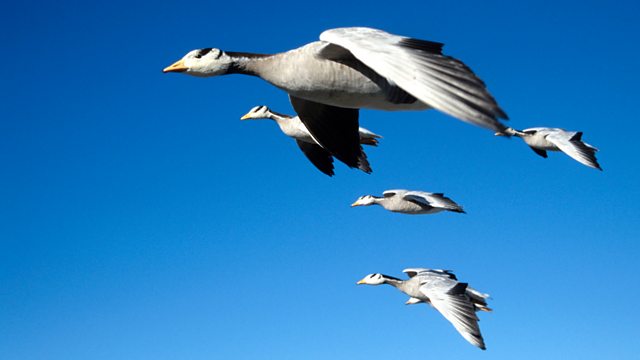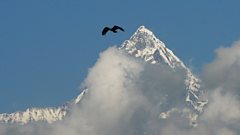How high can birds fly?
What鈥檚 the greatest altitude birds can cope with, and which species soars highest? We investigate a question from listener Alison from Australia.
While watching a feisty cockatoo chase after a hawk, CrowdScience listener Alison saw the hawk catch a thermal and rise effortlessly into the sky. The cockatoo gave chase, but the hawk climbed higher and higher until it became just a tiny speck, barely visible to the naked eye.
And that got Alison thinking: just how high can birds go? Are there altitude limits for our feathered friends? Could a cockatoo, a sparrow, or even a duck reach such dizzying heights if they really put their wings to it?
Presenter Alex Lathbridge sets out to investigate. Biologist Catherine Ivy reveals that life above the clouds isn鈥檛 easy. At high altitudes, the air is thinner, oxygen is scarce, and wings don鈥檛 generate as much lift. But some bird species have evolved incredible adaptations to overcome these challenges.
Among them: bar-headed geese, renowned for their daring flights over the world鈥檚 tallest mountains. Physiologist Lucy Hawkes delves into how these geese defy the odds with their remarkable physiology, revealing the surprising discoveries she made while putting some of them on a treadmill.
From super-powered hearts to clever lungs, we uncover the secrets behind nature鈥檚 impressive aviators.
Presenter: Alex Lathbridge
Producers: Ilan Goodman and Jeremy Grange
Editor: Cathy Edwards
Production co-ordinator: Ishmael Soriano
Technical producer: Sarah Hockley
Last on
More episodes
Clip
-
![]()
How do birds survive so high up?
Duration: 02:13
Featured
-
.
Broadcasts
- Fri 24 Jan 2025 20:32GMT大象传媒 World Service Online, Americas and the Caribbean, UK DAB/Freeview & Europe and the Middle East only
- Fri 24 Jan 2025 21:32GMT大象传媒 World Service except Online, Americas and the Caribbean, Europe and the Middle East & UK DAB/Freeview
- Mon 27 Jan 2025 02:32GMT大象传媒 World Service
- Mon 27 Jan 2025 05:32GMT大象传媒 World Service Australasia, Americas and the Caribbean, South Asia & East Asia only
- Mon 27 Jan 2025 09:32GMT大象传媒 World Service
- Mon 27 Jan 2025 13:32GMT大象传媒 World Service East and Southern Africa, News Internet & West and Central Africa only
Podcast
-
![]()
CrowdScience
Answering your questions about life, Earth and the universe



